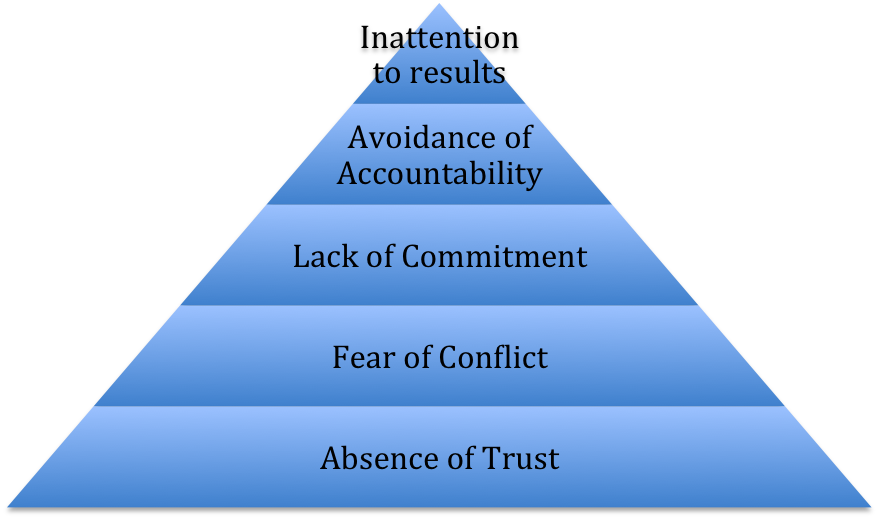How to build trust within a team – A Case Study
A few months ago, I was working with a team around positive team dynamics and we spent some time working our way through the Patrick Lencioni model of “The Five Dysfunctions of a Team”.
The Lencioni Model – “The Five Dysfunctions of a Team”
Lencioni’s model is a beautifully simple and elegant articulation of what is needed for a team to function at its best; and the dysfunctions that often get in the way of high performing, productive teams.
Most of us have worked in teams where one or more of these dysfunctions have been present, and know first hand how debilitating they can be. It can be hard though; even knowing what the issues are – to change the behaviours of a team individually and collectively.

Lencioni Model : The Five Dysfunctions of a Team
The Case Study – A Senior Ops Team within a well-known and high profile organization
So today, in the first of a series of case studies, I wanted to track another team’s progress; one that has been working through the model for a while now. It’s always useful to have a case study of how the theory works in real life.
The case study profiles a senior operational team that works as part of a well-known and high profile organization.
My brief was to undertake an evaluation of the team. Using a strengths’ based approach and face to face interviews based on the Lencioni model, I concluded that whilst there was lots that was positive about the team, there were some fundamental issues within the team that were contributing to them not performing as effectively as they could.
Step One – Building Trust within the Team
Fortunately the team is blessed with a leader who cares about the dynamics and performance of the team and who was prepared to invest time and money into doing things differently. In this case, using the Lencioni model as a structure to assist with addressing the issues that were affecting performance within the team.
First and foremost, they addressed the absence of trust within the team.
Lencioni defines trust as: “.. the confidence among team members that their peers’ intentions are good, and that there is no need to be protective or careful around the group. In essence, teammates must get comfortable being vulnerable around each other..”
A couple of things on this; firstly – Brene Brown presents very strong evidence around the extraordinary power of vulnerability and the positive impact that this can have within leadership and teams. And secondly, Stephen Covey’s Speed of Trust makes the point that trust can be built (or rebuilt as the case may be).
So whilst trust is an emotive word, and the absence of trust sounds like a difficult issue to resolve, there is clear evidence that 1) it’s critical and 2) it can be done!
So back to our case study team – has it worked for them? The leader has this to say:
“Whilst not all wine and roses, I am confident that the short answer is yes, that there has been an increase in trust within the team. This is evident to me in that the team is engaging with each other much more and I’ve personally witnessed them calling each other on non-supportive behaviours… A by product of this has been that they feel/act much more like a cohesive unit… I have also heard second hand that at meeting individuals within the leadership group will stand up for the interests of any absent members of the team..”
What worked to build trust?
Whilst there has been a structured programme to support the team, including weekly questionnaires to check in and facilitated workshops; three of the steps that seem to have made a difference are relatively simple and easy to implement.
- The issue of vulnerability was addressed by getting to know each other better and on a more personal level. The leader makes the point that whilst early on there were some pretty diabolical dinners with very awkward silences; that investing in routine social engagements paid off;
- There was agreement around the behaviours, both positive and negative that the team wanted to see and an agreement to support and call each other on those behaviours; and
- Being strict around team meetings and other engagements– no shows and double bookings became unacceptable behaviour – being strict on this became a symbol that the team matters.
What next for the team?
There is no doubt that the team has some way to go and will need to continue to build its maturity over time. It’s not a linear process, sometimes it is a one step forward, two steps back as rogue behaviours within the team derail the process temporarily.
And of course, trust is only the first component that needs to be addressed.
The power in any sustainable organisational change is to be clear on the ongoing approach once the initial enthusiasm has worn off.
Trust is also built by doing what you say you are going to do; so having a well mapped out approach from the start (with flexibility to adapt as circumstances arise) can be a powerful change agent in itself.
As an advisor that comes in and out of organisations; it is always gratifying to see when the theory works.
Yes, there is still some way to go. Yes, it is not perfect. But as I have said many times before on this blog, it is often the most simple of approaches that will have the most impact. And often, there is a disproportionately positive return on investment.
Tell me about a time that you had a win where relatively simple actions had a big pay off? What happened?
Thanks to elev8.com for the image

